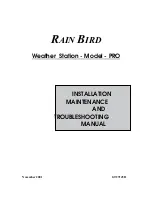
PILOT’S
GUIDE
47
STRIKE FINDER
DIGITAL WEATHER AVOIDANCE
WEATHER AVOIDANCE SYSTEMS
There are two types of on-board storm avoidance systems—lightning
detectors and radar.This section will highlight the differences and similarities
of the two systems.
Strike Finder System
The Strike Finder system maps lightning. Unlike radar which detects
water only, the Strike Finder detects and analyzes the electrical activity
(lightning) emanating from thunderstorms.Where lightning is, thunderstorms
exist, and so do the other hazards associated with them.
The electromagnetic signals are routinely received by a sensor. Strike Finder
uses advanced
Digital Signal Processing
technology to analyze the
severity, and bearing, relative to your aircraft. The information is depicted
on the Strike Finder display as one cohesive picture of weather mapping.
Strike Finder Advantages
The Strike Finder system and its unique patented processing of lightning
signals has some very important advantages over weather radar.
•
Digital Signal Processing
for high fidelity weather modeling.
•
High resolution display for detailed weather mapping.
•
Identifies thunderstorms before rain starts—radar sees nothing.
•
Full-time 360-degree view makes interpretation of both hazards and
avoidance paths simple.
•
Zoom control
provides enhanced weather depiction for 200, 100,
50, and 25 nm.
•
Works on the ground! You plan your hazard avoidance routes at
start-up—on board radar can not.
•
Attenuation is NOT a factor! Strike Finder shows ALL the activity,
(see Figure 40, p.48).
Strike Finder Pilot's Guide fix 9/19/05 10:59 AM Page AZ
















































